- Electric and Telecom Plans Free
- Fire and Emergency Plans Free
- Floor Plans Free
- Plant Layout Plans Free
- School and Training Plans Free
- Seating Plans Free
- Security and Access Plans Free
- Site Plans Free
- Sport Field Plans Free
- Business Process Diagrams Free
- Business Process Mapping Free
- Classic Business Process Modeling Free
- Cross-Functional Flowcharts Free
- Event-driven Process Chain Diagrams Free
- IDEF Business Process Diagrams Free
- Logistics Flow Charts Free
- Workflow Diagrams Free
- ConceptDraw Dashboard for Facebook Free
- Mind Map Exchange Free
- MindTweet Free
- Note Exchange Free
- Project Exchange Free
- Social Media Response Free
- Active Directory Diagrams Free
- AWS Architecture Diagrams Free
- Azure Architecture Free
- Cisco Network Diagrams Free
- Cisco Networking Free
- Cloud Computing Diagrams Free
- Computer Network Diagrams Free
- Google Cloud Platform Free
- Interactive Voice Response Diagrams Free
- Network Layout Floor Plans Free
- Network Security Diagrams Free
- Rack Diagrams Free
- Telecommunication Network Diagrams Free
- Vehicular Networking Free
- Wireless Networks Free
- Comparison Dashboard Free
- Composition Dashboard Free
- Correlation Dashboard Free
- Frequency Distribution Dashboard Free
- Meter Dashboard Free
- Spatial Dashboard Free
- Status Dashboard Free
- Time Series Dashboard Free
- Basic Circle-Spoke Diagrams Free
- Basic Circular Arrows Diagrams Free
- Basic Venn Diagrams Free
- Block Diagrams Free
- Concept Maps Free
- Family Tree Free
- Flowcharts Free
- Basic Area Charts Free
- Basic Bar Graphs Free
- Basic Divided Bar Diagrams Free
- Basic Histograms Free
- Basic Line Graphs Free
- Basic Picture Graphs Free
- Basic Pie Charts Free
- Basic Scatter Diagrams Free
- Aerospace and Transport Free
- Artwork Free
- Audio, Video, Media Free
- Business and Finance Free
- Computers and Communications Free
- Holiday Free
- Manufacturing and Maintenance Free
- Nature Free
- People Free
- Presentation Clipart Free
- Safety and Security Free
- Analog Electronics Free
- Audio and Video Connectors Free
- Basic Circuit Diagrams Free
- Chemical and Process Engineering Free
- Digital Electronics Free
- Electrical Engineering Free
- Electron Tube Circuits Free
- Electronic Block Diagrams Free
- Fault Tree Analysis Diagrams Free
- GHS Hazard Pictograms Free
- Home Automation and Wiring Free
- Mechanical Engineering Free
- One-line Diagrams Free
- Power Сircuits Free
- Specification and Description Language (SDL) Free
- Telecom and AV Circuits Free
- Transport Hazard Pictograms Free
- Data-driven Infographics Free
- Pictorial Infographics Free
- Spatial Infographics Free
- Typography Infographics Free
- Calendars Free
- Decision Making Free
- Enterprise Architecture Diagrams Free
- Fishbone Diagrams Free
- Organizational Charts Free
- Plan-Do-Check-Act (PDCA) Free
- Seven Management and Planning Tools Free
- SWOT and TOWS Matrix Diagrams Free
- Timeline Diagrams Free
- Australia Map Free
- Continent Maps Free
- Directional Maps Free
- Germany Map Free
- Metro Map Free
- UK Map Free
- USA Maps Free
- Customer Journey Mapping Free
- Marketing Diagrams Free
- Matrices Free
- Pyramid Diagrams Free
- Sales Dashboard Free
- Sales Flowcharts Free
- Target and Circular Diagrams Free
- Cash Flow Reports Free
- Current Activities Reports Free
- Custom Excel Report Free
- Knowledge Reports Free
- MINDMAP Reports Free
- Overview Reports Free
- PM Agile Free
- PM Dashboards Free
- PM Docs Free
- PM Easy Free
- PM Meetings Free
- PM Planning Free
- PM Presentations Free
- PM Response Free
- Resource Usage Reports Free
- Visual Reports Free
- House of Quality Free
- Quality Mind Map Free
- Total Quality Management TQM Diagrams Free
- Value Stream Mapping Free
- Astronomy Free
- Biology Free
- Chemistry Free
- Language Learning Free
- Mathematics Free
- Physics Free
- Piano Sheet Music Free
- Android User Interface Free
- Class Hierarchy Tree Free
- Data Flow Diagrams (DFD) Free
- DOM Tree Free
- Entity-Relationship Diagram (ERD) Free
- EXPRESS-G data Modeling Diagram Free
- IDEF0 Diagrams Free
- iPhone User Interface Free
- Jackson Structured Programming (JSP) Diagrams Free
- macOS User Interface Free
- Object-Role Modeling (ORM) Diagrams Free
- Rapid UML Free
- SYSML Free
- Website Wireframe Free
- Windows 10 User Interface Free
Biomedicine
Biomedicine is a branch of medicine that studies a human body, its structure and functions in normal and pathological conditions, methods of diagnosis of different diseases, correction and their treatment. It includes knowledge accumulated by the medicine and fundamental biological sciences such as chemistry, biological chemistry, biology, histology, genetics, embryology, anatomy, physiology, pathology, biomedical engineering, zoology, botany, and microbiology, and expands the boundaries of the medical knowledge about the human body. The biomedicine is based on the natural methods of treating diseases and pathological states, natural mechanisms that a human body possesses to protect itself from diseases. The biomedicine allowed looking at the process of treatment of the number of diseases and the possibilities of medicine in general from a different perspective, this is exactly what made analysis and diagnostics even more accurate, and led the medicine and biomedical technology to the qualitatively new level. The results of biomedicine researches and biotechnological developments introduced new technologies in the treatment of rare and severe diseases, as well as those that were previously considered incurable, developed and produced the innovative medicines, vaccines and induced stem cells for the cell therapy.
The Biomedicine solution extends the ConceptDraw DIAGRAM vector diagramming software with an abundance of samples and libraries of vector biomedical icons, pictograms of biomedical sciences and biomedical technologies, the main purpose of which is to help to visually describe and illustrate new achievements and new technologies in biomedicine, results of experiments and tests in this field, to depict the history of biomedicine development, its stages and progress, to plan future biomedicine technologies and to describe those that are now in development or at the stage of testing by biomedical specialists. The tools of the Biomedicine solution are perfect for helping the biomedical doctors, biomedical researchers, scientific professionals, professors in biomedical science, technicians, lectors, students in designing the colourful and professionally looking illustrations, diagrams, presentation slides and infographics in fields of biomedicine, personalized medicine, regenerative medicine, molecular medicine, evidence-based medicine, reconstructive biomedicine, preventive healthcare, and medical technologies of diagnosis and treatment of diseases.
-
Buy this solution $49 -
Solution Requirements - This solution requires the following products to be installed:
ConceptDraw DIAGRAM v18 - This solution requires the following products to be installed:
-
Compatibility - Sonoma (14), Sonoma (15)
MS Windows 10, 11 - Sonoma (14), Sonoma (15)
-
Support for this Solution -
Helpdesk
This solution contains 10 examples and 3 libraries containing 144 vector graphics and icons, to allow you to create professional looking documents.
Design Elements — Biomedical Sciences
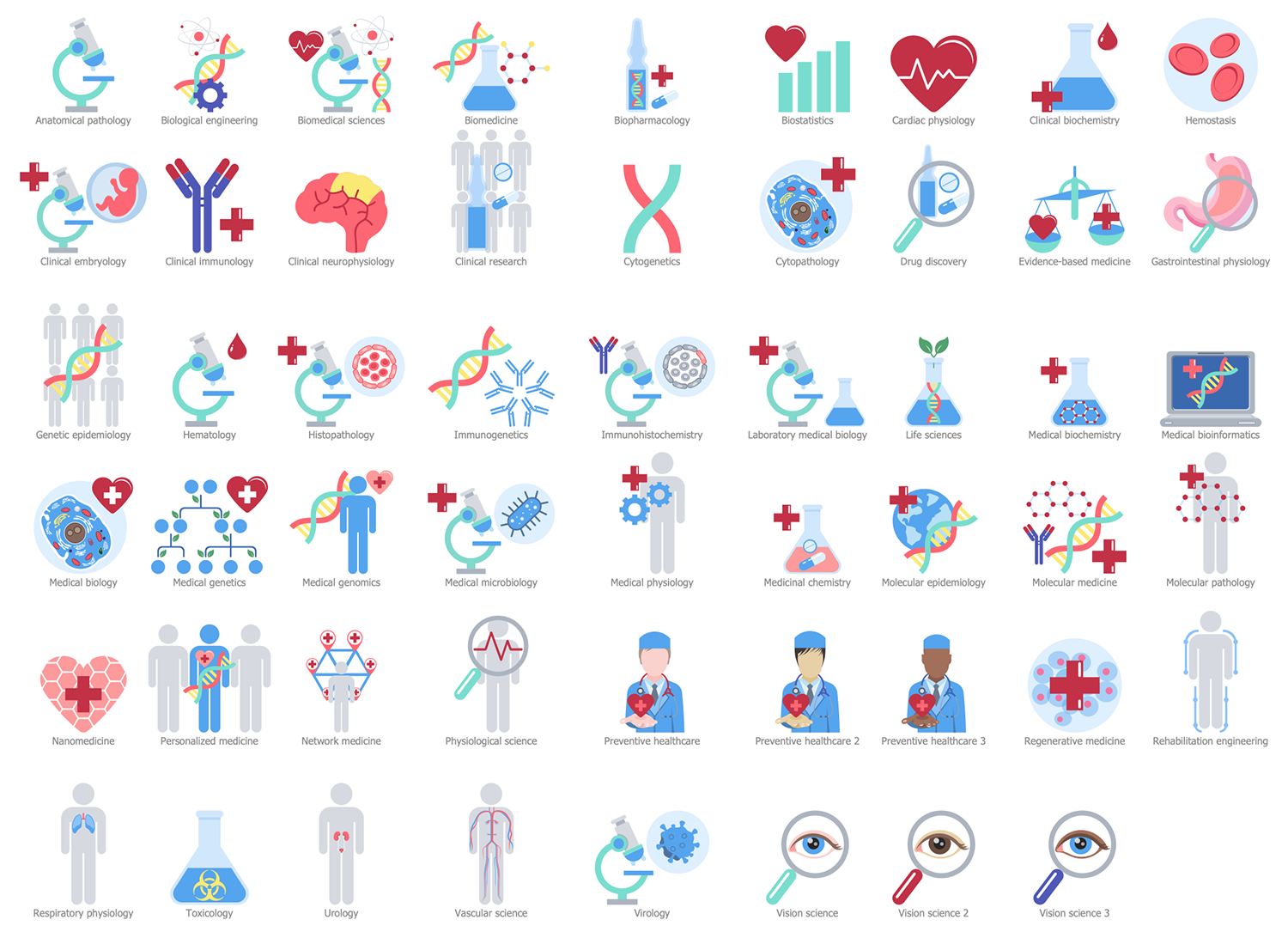
Design Elements — Biomedical Technologies
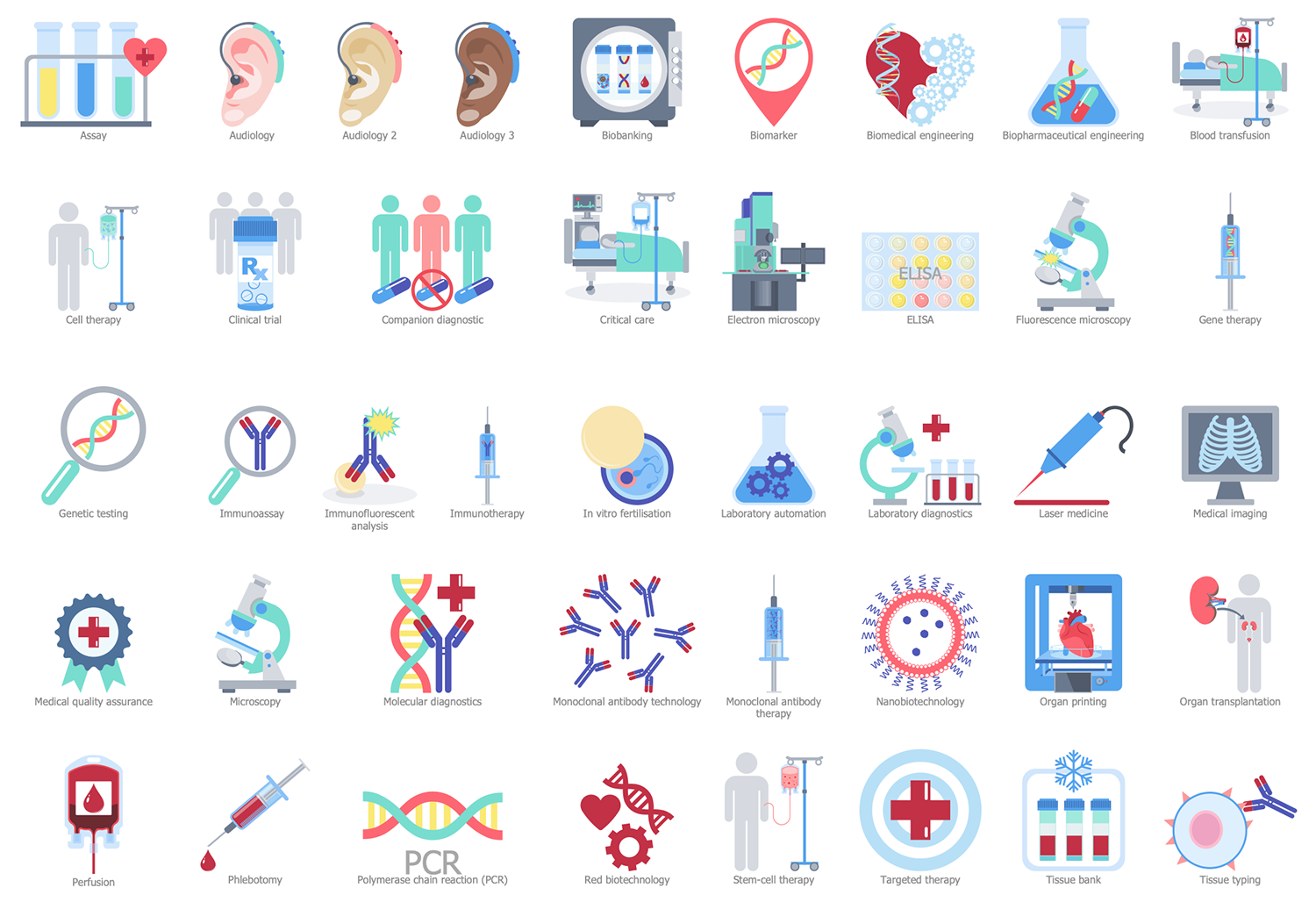
Design Elements — Biomedical Icons
Related News:
Examples
There are a few samples that you see on this page which were created in the ConceptDraw DIAGRAM application by using the Biomedicine solution. Some of the solution's capabilities as well as the professional results which you can achieve are all demonstrated here on this page.
All source documents are vector graphic documents which are always available for modifying, reviewing and/or converting to many different formats, such as MS PowerPoint, PDF file, MS Visio, and many other graphic ones from the ConceptDraw Solution Park or ConceptDraw STORE. The Biomedicine solution is available to all ConceptDraw DIAGRAM users to get installed and used while working in the ConceptDraw DIAGRAM charting and drawing software.
Example 1: Biomedical Sciences
This diagram was created in ConceptDraw DIAGRAM using the composition of libraries from the Biomedicine solution. An experienced user spent 5 minutes creating this sample.
The biomedical sciences are the kind of applied sciences, which apply the knowledge, developments, newest technologies, and equipment of the fields of natural and formal sciences to the medicine, healthcare and public health fields. Among the common examples of biomedical sciences, there can be designated the medical microbiology, bioengineering, biomedical engineering, clinical virology, genetic epidemiology, clinical epidemiology, biochemistry, and other medical sciences. This Healthcare Bubble Diagram sample demonstrates the divisions of biomedical sciences. You can see three directions: physiological science, physics and bioengineering, and life sciences specialties. All of them surround the main topic of this diagram and are connected to it with the arrows. Moreover, for visual clarity, all diagram's objects are accompanied with pictures taken from the libraries of the Biomedicine solution. The clearness and attractiveness of any of your diagrams or infographics pretty much depend on bright pictures, illustrations, symbols and other graphic signs.
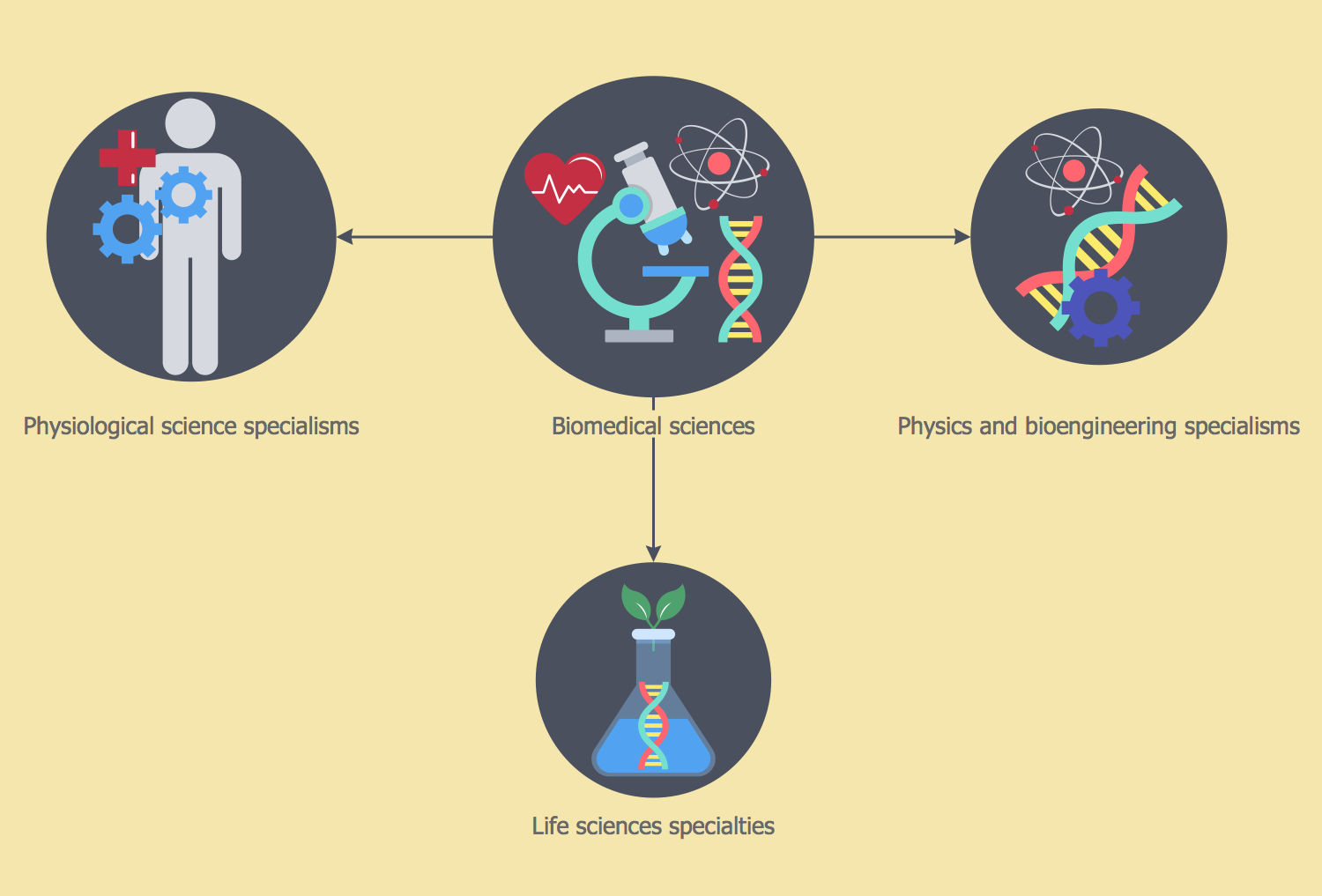
Example 2: Biomedical Sciences — Life Sciences
This diagram was created in ConceptDraw DIAGRAM using the composition of libraries from the Biomedicine solution. An experienced user spent 10 minutes creating this sample.
This biomedical infographic shows the life science specialties: analytical toxicology, anatomical pathology, histopathology and cytopathology, blood transfusion, molecular genetics and cytogenetic, cervical cytology, microbiology including mycology, clinical biochemistry, clinical embryology, histocompatibility and immunogenetics, hemostasis and thrombosis, virology, hematology, tissue banking / transplant, external quality assurance, phlebotomy, electron microscopy, clinical immunology. This diversity is caused by the active development of science and achievements in a field of medicine and biomedicine, molecular biology, biotechnology and bioengineering. The life sciences are engaged in studying the microorganisms, plants and animals meaning the organisms of different kinds, and considerations related to them. They are applied in medicine, healthcare and pharmaceuticals, as well as in agriculture and food science and can significantly improve the level and quality of life. This diagram looks cute and smooth due to the ability to design diagrams yourself in ConceptDraw DIAGRAM – you can arrange your objects around the main one the way you like.
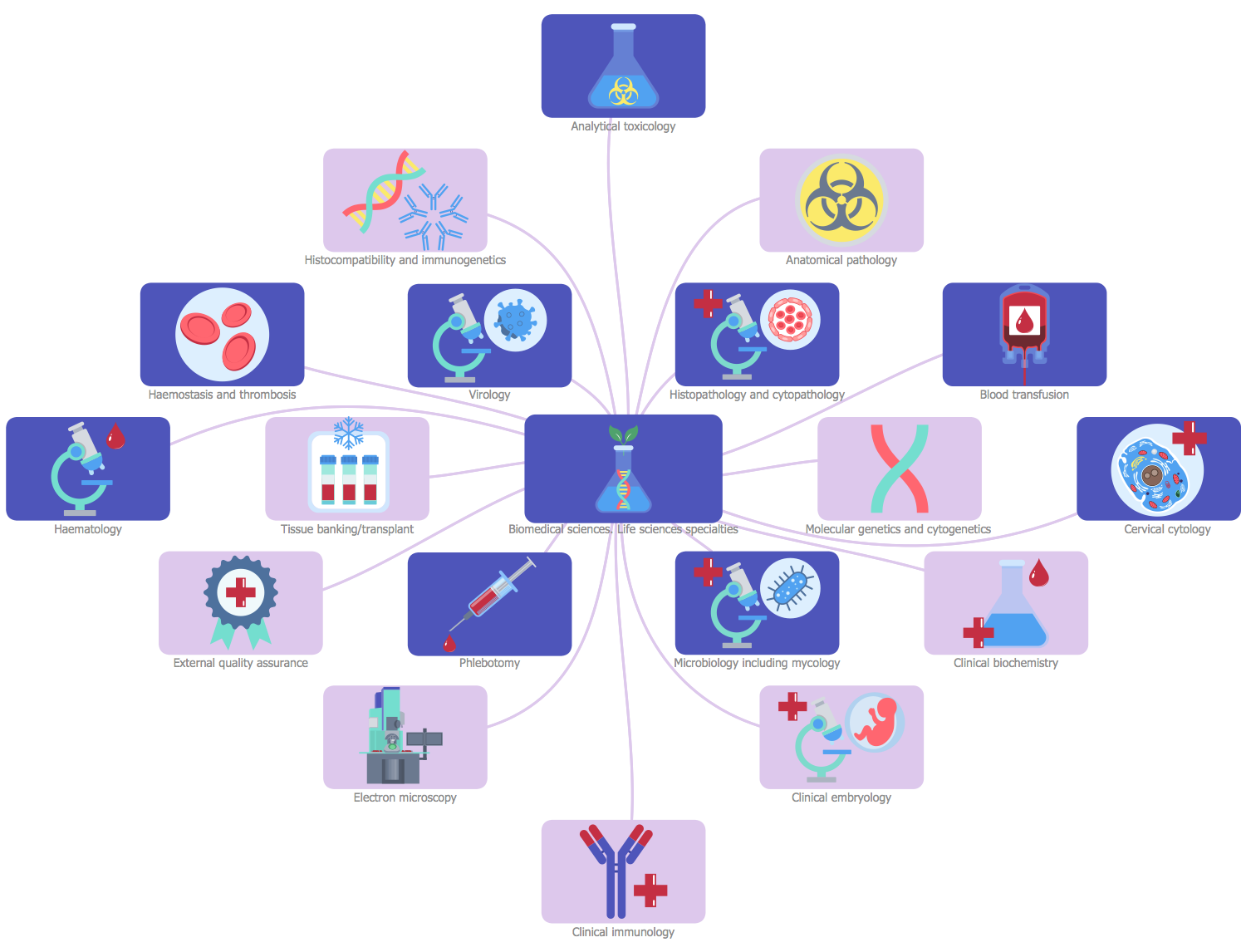
Example 3: Biomedical Sciences Physics and Bioengineering
This diagram was created in ConceptDraw DIAGRAM using the composition of libraries from the Biomedicine solution. An experienced user spent 10 minutes creating this sample.
This Affine diagram sample demonstrates the group of biomedical science specialties, such as the medical physics and biological engineering specialties. Among them, there are distinguished biomechanical engineering, biomedical engineering, clinical engineering, clinical measurement, diagnostic radiology, equipment management, maxillofacial prosthetics, medical electronics, medical engineering design, non-ionizing radiation, nuclear medicine, radiopharmacy, radiation protection and monitoring, radiotherapy physics, rehabilitation engineering, renal technology and science, ultrasound. All of them are depicted in this diagram sample with corresponding medical illustrations. The medical physics is the application of physics concepts, theories and methods to the medicine and healthcare, in turn the biological engineering is the application of engineering principles and design concepts to the same areas. By applying knowledge and skills from each field, these sciences aim to improve existing and to devise new methods of diagnostics, monitoring, and treatment in a field of medicine and healthcare, to bring these areas to the new more advanced and qualitative level.
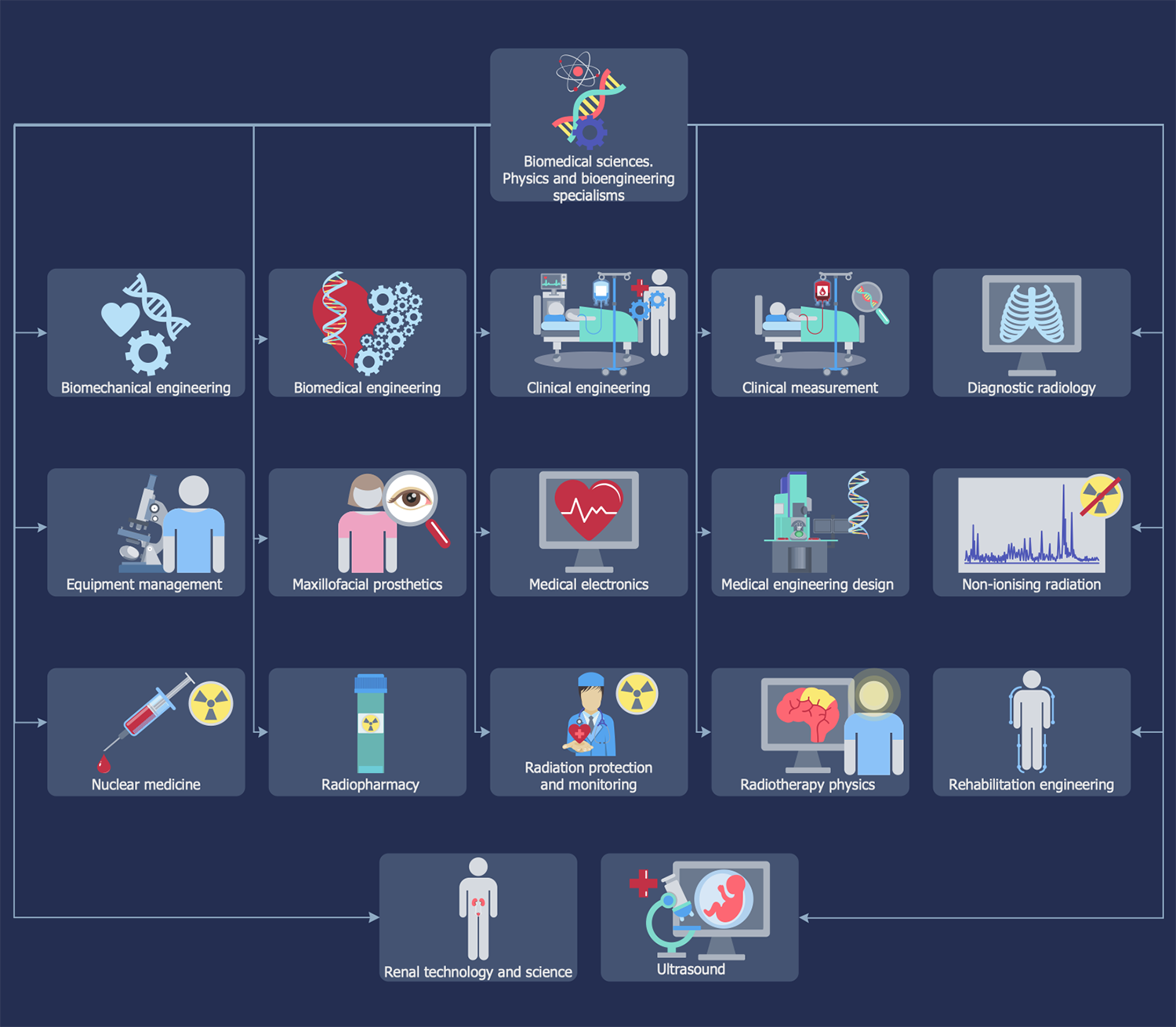
Example 4: Biomedical Sciences — Physiological Science
This diagram was created in ConceptDraw DIAGRAM using the composition of libraries from the Biomedicine solution. An experienced user spent 10 minutes creating this sample.
The physiology is a science about the mechanical, physical and biochemical functions of a human. This biological science is a basis for the modern medicine and studies the vital activity of a healthy organism as a whole, the functioning of its separate parts — systems, organs, tissues, cells, and also systems of living organisms. The physiology science is divided into the general physiology, which studies the mechanisms of activity the excitable tissues, the laws of their irritation and excitation, and private physiology that studies the functions of various organs and their interactions within a whole organism. Besides that, the physiology science includes a huge number of different sections and specializations. This healthcare infographics sample designed in ConceptDraw DIAGRAM illustrates the physiological science specialties, among which you can observe the following: audiology and hearing therapy, ophthalmic and vision science, cardiac physiology, vascular science, critical care, gastrointestinal physiology, respiratory and sleep physiology, clinical perfusion, neurophysiology, and urology.
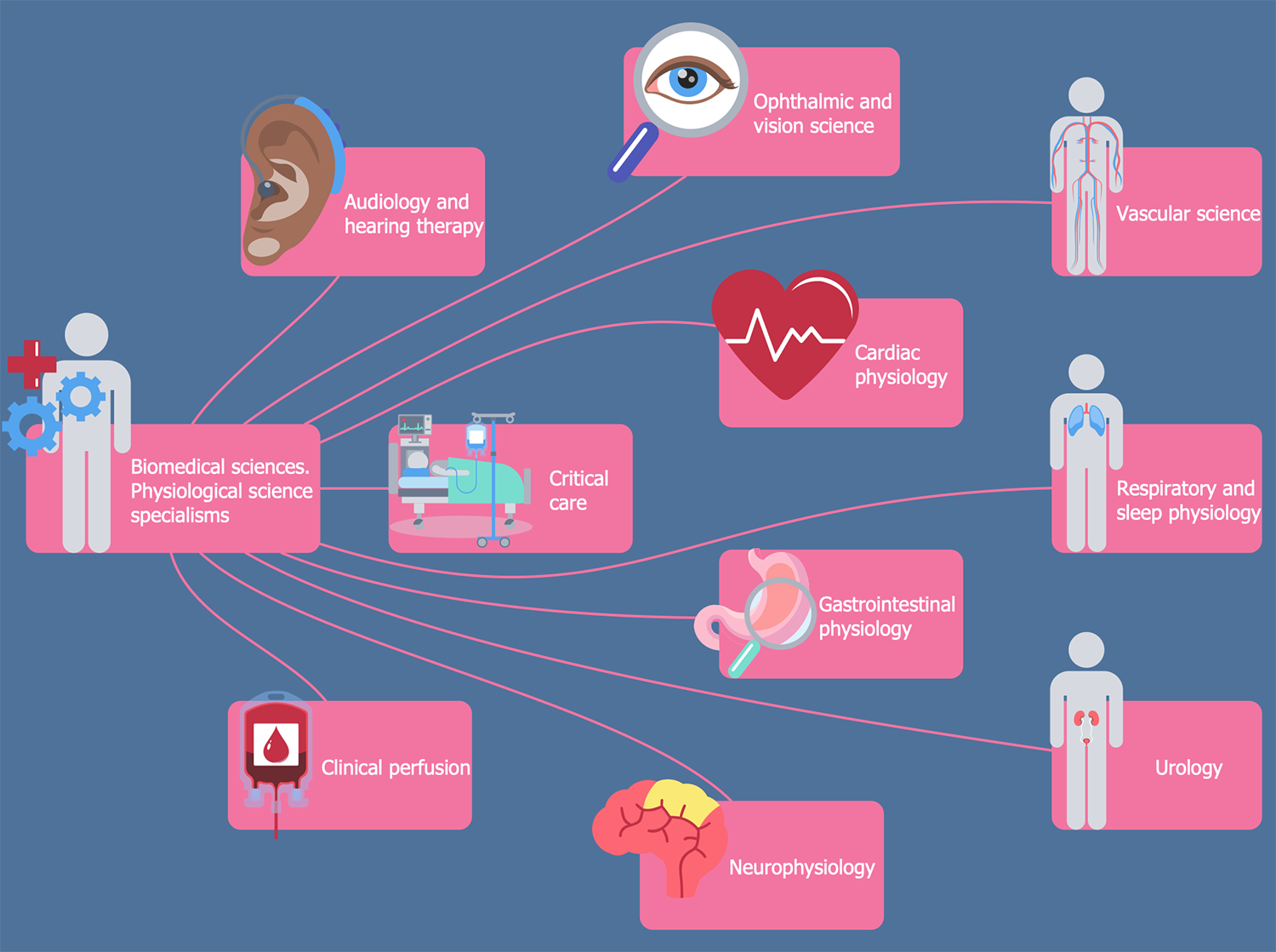
Example 5: Disease Diagnostics Using Proteomic Patterns
This diagram was created in ConceptDraw DIAGRAM using the composition of libraries from the Biomedicine solution. An experienced user spent 5 minutes creating this sample.
The active development of medicine and biomedicine led to the appearance of a large number of subdivisions in these fields, as well as the newest technologies and methods of biomedical researches, among them there are the proteomic researches and proteomic technologies in biomedical researches. This sample demonstrates the mechanism of disease diagnostics with use of proteomic patterns. At first, a sample is taken from a patient in order to be put to a protein chip having a specific chromatographic surface. After the steps of washing and application the energy-absorbing molecule, the analysis of species on a chip's surfaces via mass spectrometry takes place. With the help of special computer software, the recognition of peaks on a proteomic pattern and setting a diagnosis are performed. The use of the ConceptDraw's drawing tools and ready vector objects offered by the libraries of the Biomedicine solution lets you describe different biomedical processes in a human body and illustrate the mechanisms of biomedical researches in a visual form.
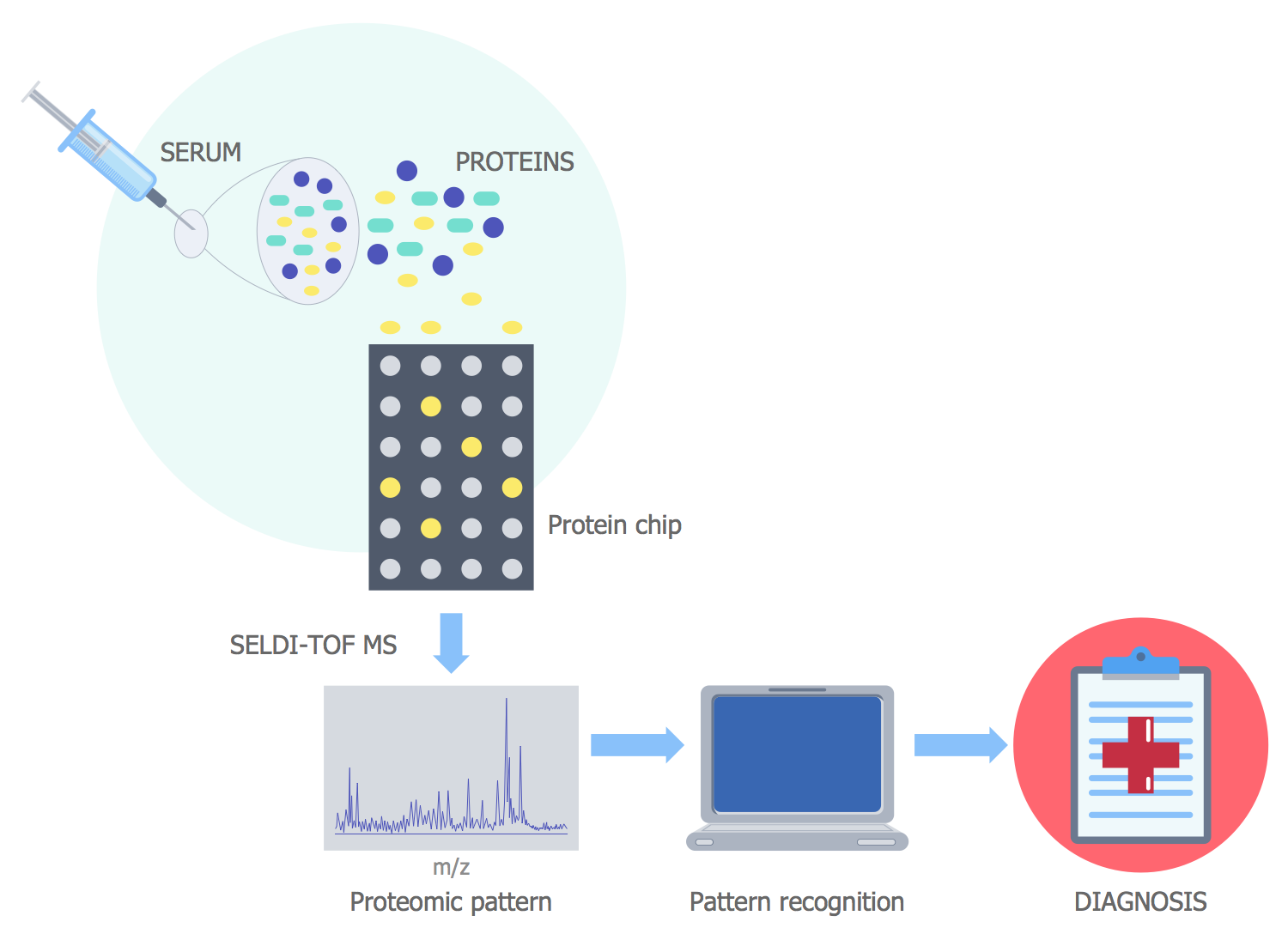
Example 6: Microarray Comparative Genomic Hybridisation
This diagram was created in ConceptDraw DIAGRAM using the composition of libraries from the Biomedicine solution. An experienced user spent 5 minutes creating this sample.
This sample demonstrates the microarray comparative genomic hybridization method of molecular cytogenetics, which is used for analysis of copy number variations (CNVs) relative to the ploidy level in DNA allowing detecting the unbalanced chromosomal abnormalities. There is no need for culturing the cells since the test sample can be easily compared with a reference one, as well as two closely related genomic DNA samples from the different sources can be also compared with each other, if needed. The procedure of comparative genomic hybridization (CGH) makes it possible to diagnose the entire genome and is highly objective and informative method. The DNA microarray, which contains thousands of locus-specific DNA fragments is used as a tool for the execution this procedure. The analyzed DNA is hybridized with a similar microchip, each signal corresponds to a certain locus of a genome, and the change of the signal intensity indicates about the changes in a content of one or another section of chromosomes.
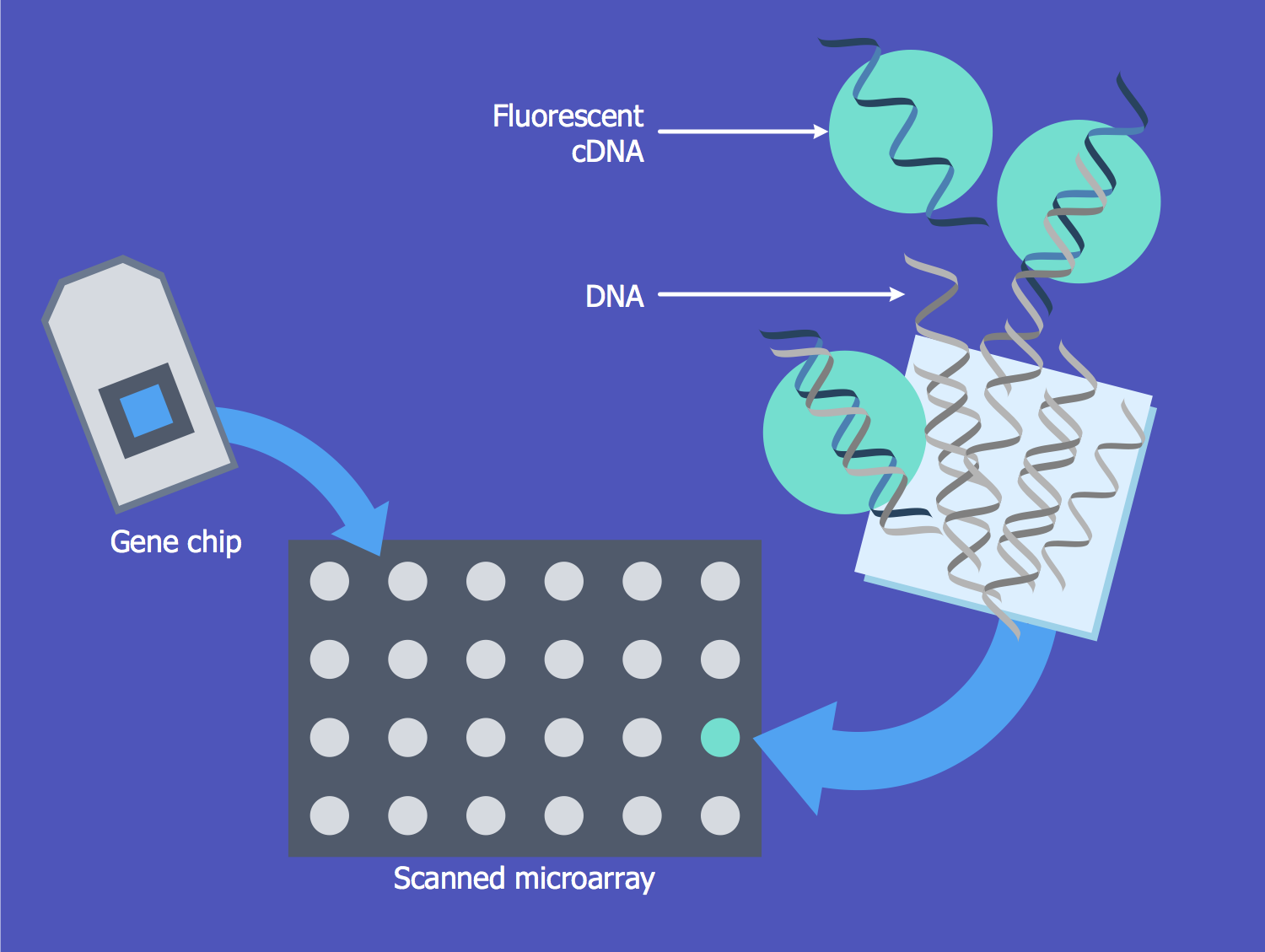
Example 7: Molecular Diagnostics
This diagram was created in ConceptDraw DIAGRAM using the composition of libraries from the Biomedicine solution. An experienced user spent 5 minutes creating this sample.
This biomedical infographics sample demonstrates the process of molecular diagnostics of cancer cells using the patient’s tissue sample or blood sample. The molecular diagnostics includes technologies and methods of two disciplines - genomics that studies genes in the cell or organism, and proteomics that studies the proteins. In its turn, the molecular diagnostics determines the mechanism of interactions the genes and proteins in a cell, allowing identifying cancer cells using genomics' technologies of mass spectrometry and proteomic image, and proteomics' technologies of gene chips and microarray image. These images will differ for the different types of cancerous or precancerous cells. So, the molecular diagnostics gives the clinicians an ability to identify and fix the changes in cells, and diagnose cancer. Describing a multi-step diagnostic process, organize the steps carefully and consistently. The excellent idea is to add some vividness to your illustration by finding the appropriate pictures and attaching them to depicted stages.
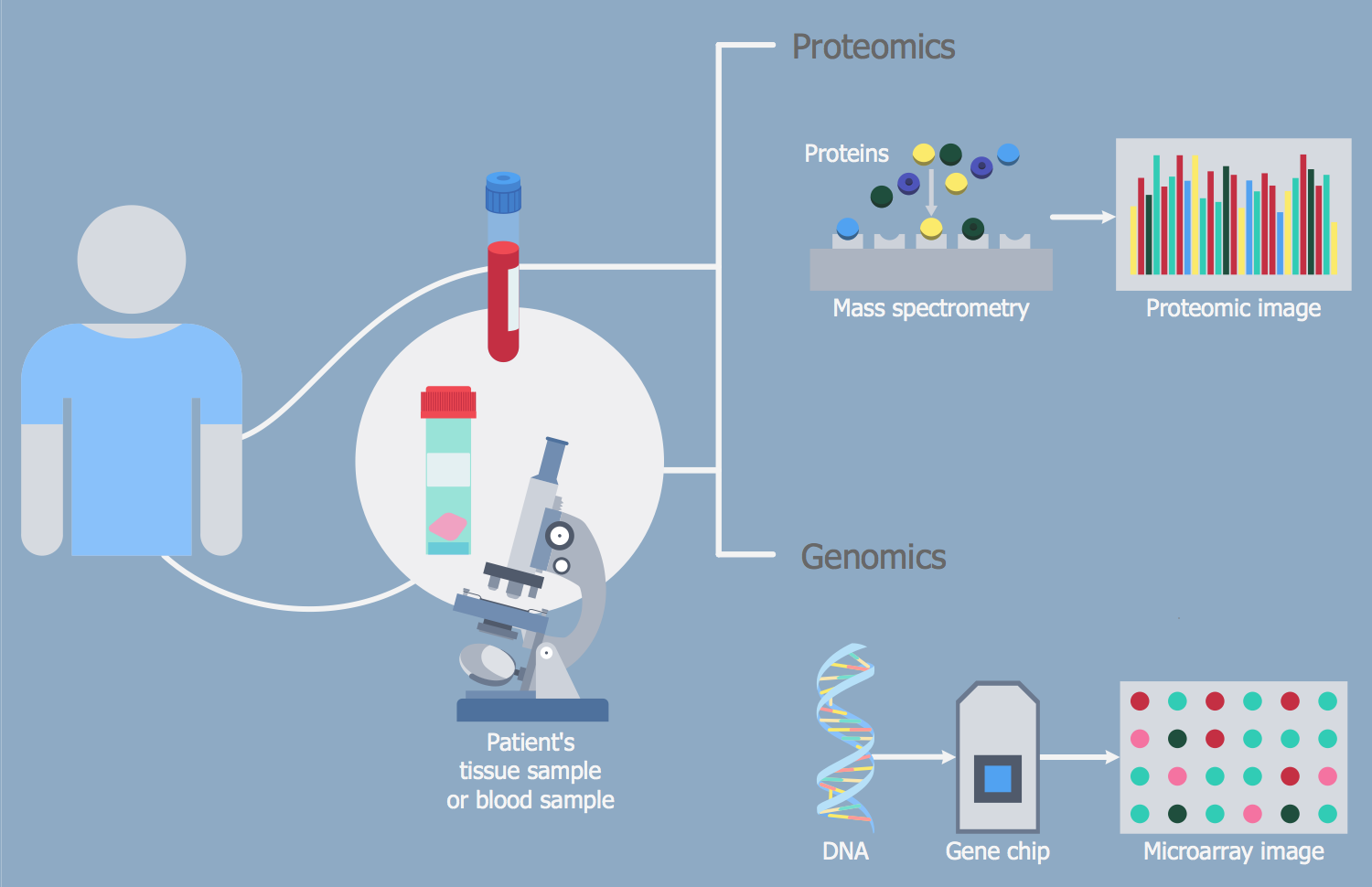
Example 8: Precision Medicine and Population Health
This diagram was created in ConceptDraw DIAGRAM using the composition of libraries from the Biomedicine solution. An experienced user spent 10 minutes creating this sample.
This biomedical diagram is dedicated to the precision medicine (PM) and population health. You can see three stages that contribute to cancer treatment and its prevention, these are the identification of opportunities for precision medicine in countering cancer, conduction of the population research, and implementation of the discovered precision applications into the programs against cancer. The precision medicine is a type of modern medicine, which supposes the personalization of treatment of different diseases as every person is a unique organism with its own individual and unique requirements and needs, so its treatment involves the individual specially-developed program. The population health approach includes many factors and actions, which are directed to the improvement of the health condition of an entire human population. The precision medicine is one of the most innovative and rapidly developed areas with large perspectives in a future, which plays a great role in the process of maintaining and strengthening the health of the population.
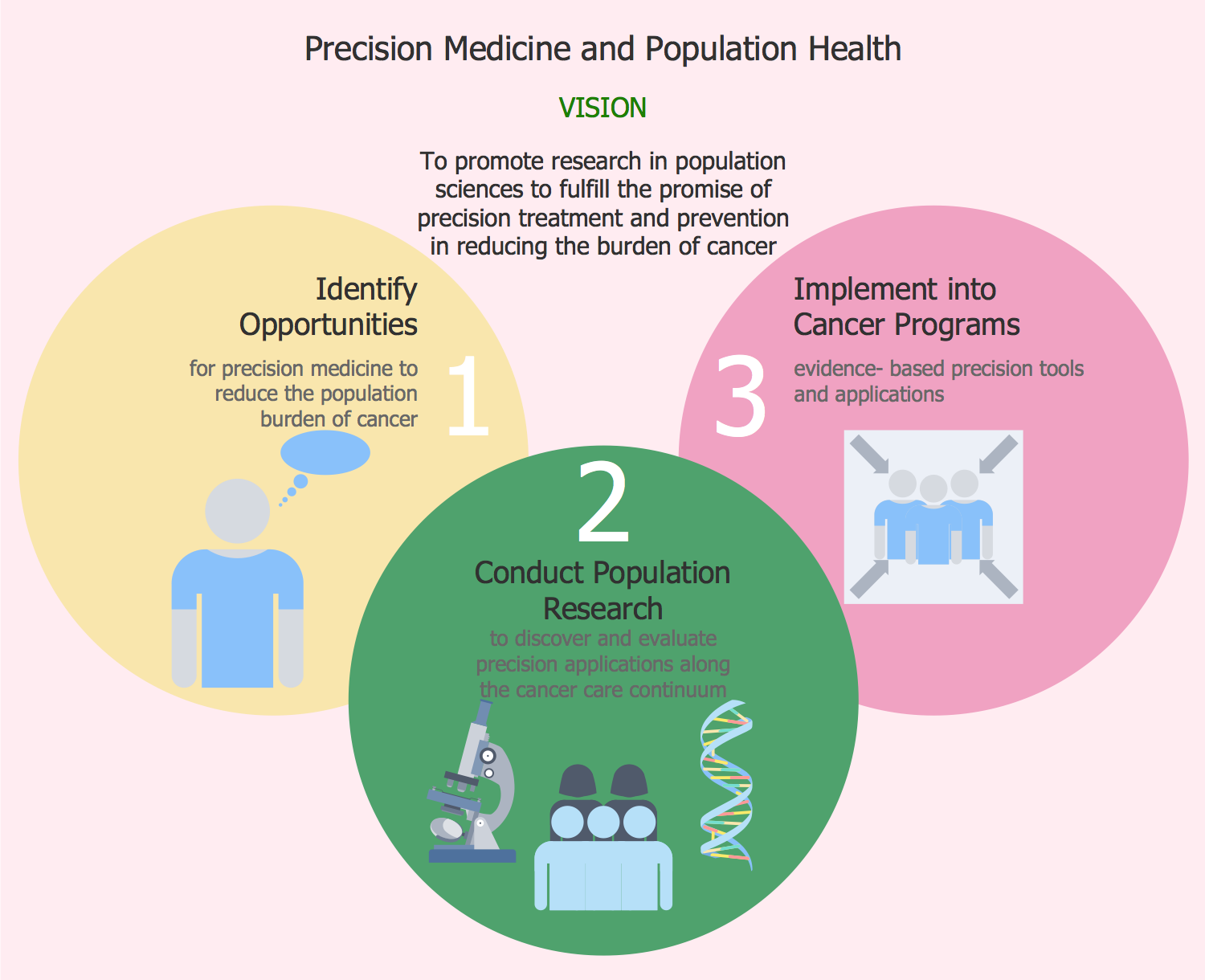
Example 9: Protein Patterns and Diagnosis
This diagram was created in ConceptDraw DIAGRAM using the composition of libraries from the Biomedicine solution. An experienced user spent 5 minutes creating this sample.
This biomedical infographics sample was designed on the base of the diagram from the website of USA National Cancer Institute (NCI) and vividly demonstrates a step-by-step process of conducting research and diagnostics using the protein patterns within the patients with ovarian cancer. The blood samples collected from this group of patients were investigated and studied, and all protein profiles using the mass spectrometry methodic were gathered from them. The use of a large number of serum samples from the patients with the similar diagnoses along with some variations from one patient to another gave specialists the opportunity to identify the markers of the ovarian cancer presence as a result of the cluster analysis. In a visual and easy for perception way, which was used for describing the method of molecular diagnostics of ovarian cancer, you can depict and illustrate many other biomedical methods of diagnostics and treatment of different diseases.
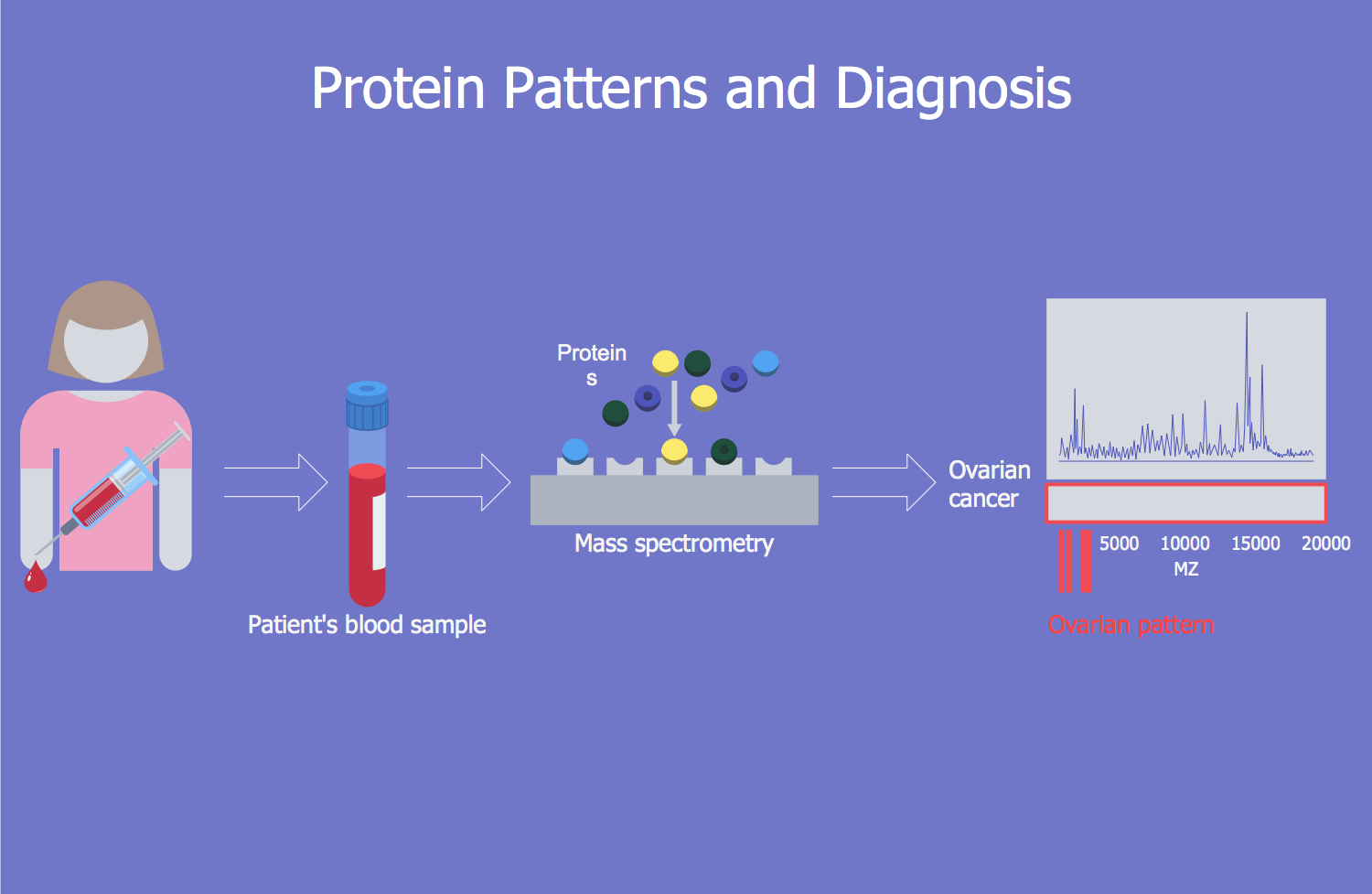
Example 10: Understanding Precision Medicine
This diagram was created in ConceptDraw DIAGRAM using the composition of libraries from the Biomedicine solution. An experienced user spent 5 minutes creating this sample.
This health infographics sample illustrates the principles of precision medicine for better understanding this field of medicine. It was designed on the base of the diagram from the "Precision Medicine in Cancer Treatment" webpage on the website of the National Cancer Institute, USA. The precision medicine is an approach to treating patients on the base of personalized medicine with taking into account a human's genetic. Guided by the precision medicine approach, doctors are free to choose the methods of patients' treatment based on a genetic understanding of their disease. At the moment, due to the active development of science and technologies the precision medicine is also rapidly developed and became quite popular, especially in treatment the most difficult and dangerous diseases, such as cancer. This approach now allows treating diseases much more effectively than before and in the future will take a paramount place among all variety of medicine approaches and biomedical technology methods.
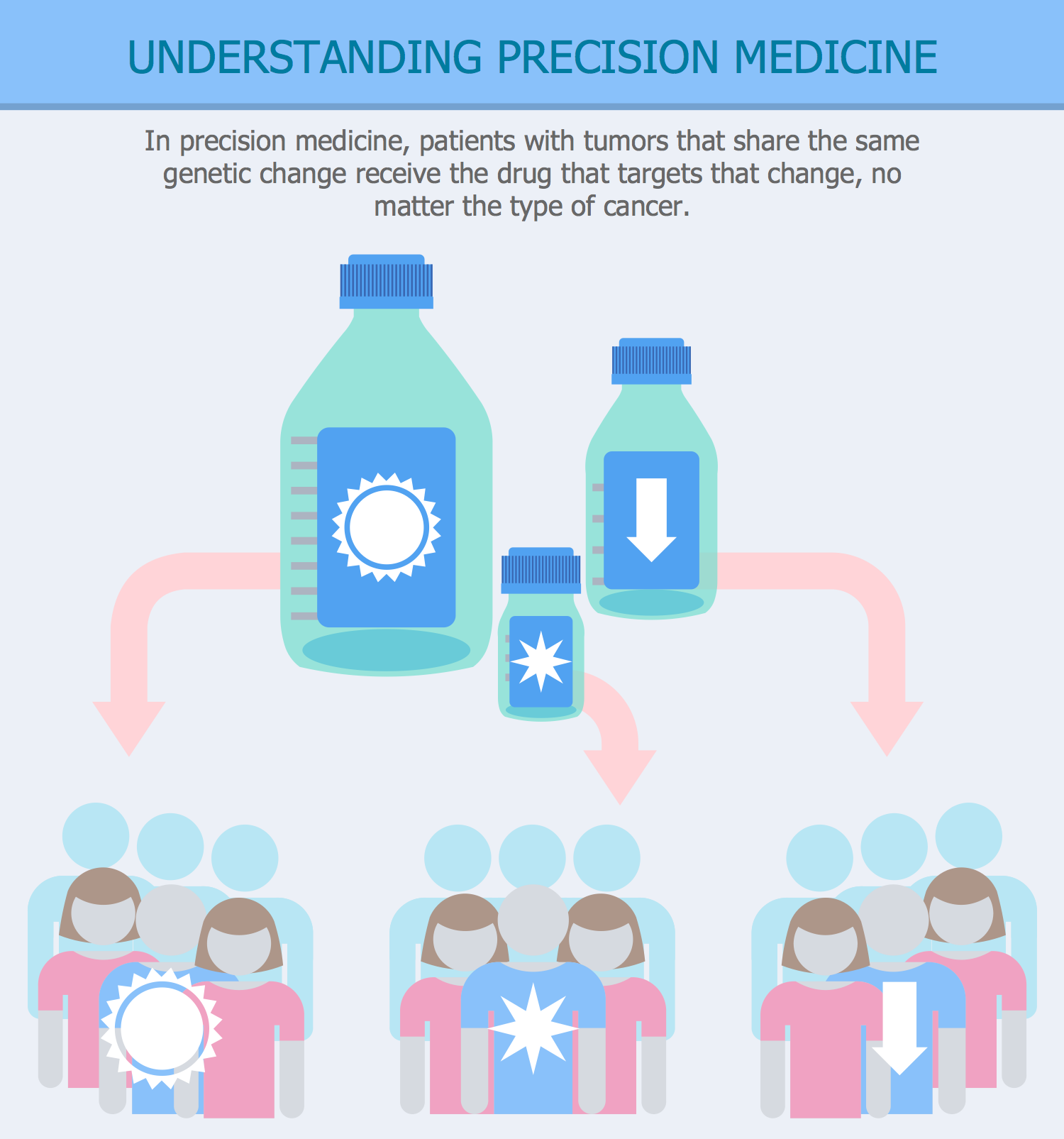
Inside
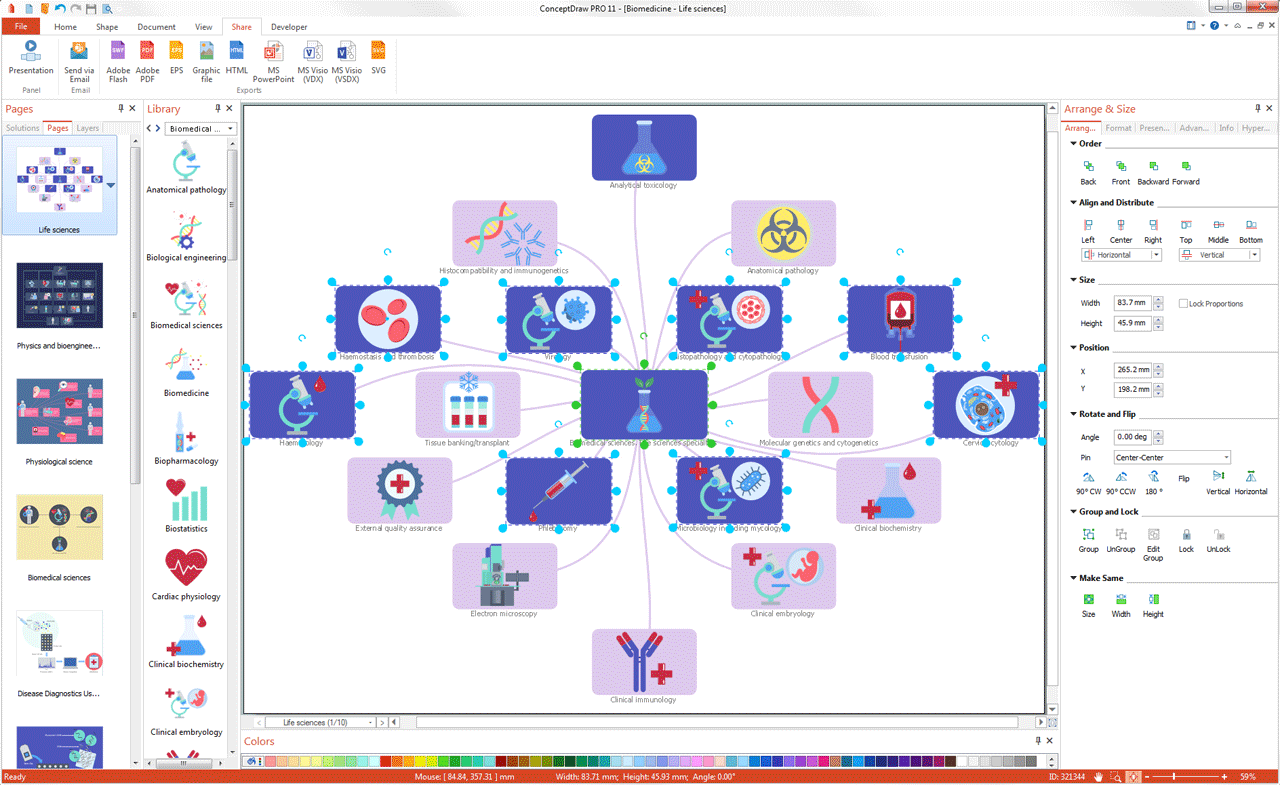
What I Need to Get Started
After ConceptDraw DIAGRAM is installed, the Biomedicine solution can be purchased either from the Health area of ConceptDraw STORE itself or from our online store. Thus, you will be able to use the Biomedicine solution straight after.
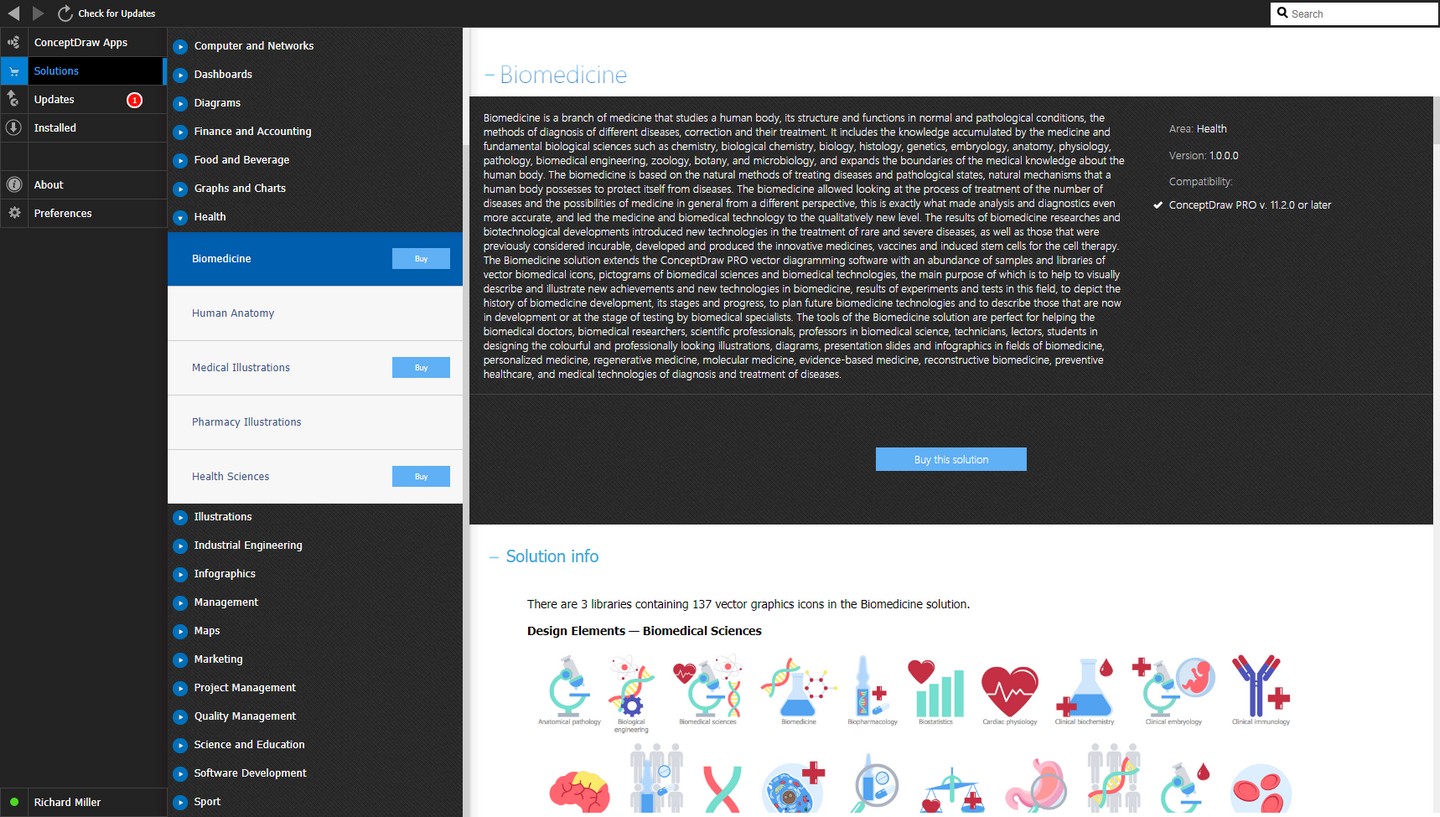
How to install
First of all, make sure that both ConceptDraw STORE and ConceptDraw DIAGRAM applications are downloaded and installed on your computer. Next, install the Biomedicine solution from the ConceptDraw STORE to use it in the ConceptDraw DIAGRAM application.
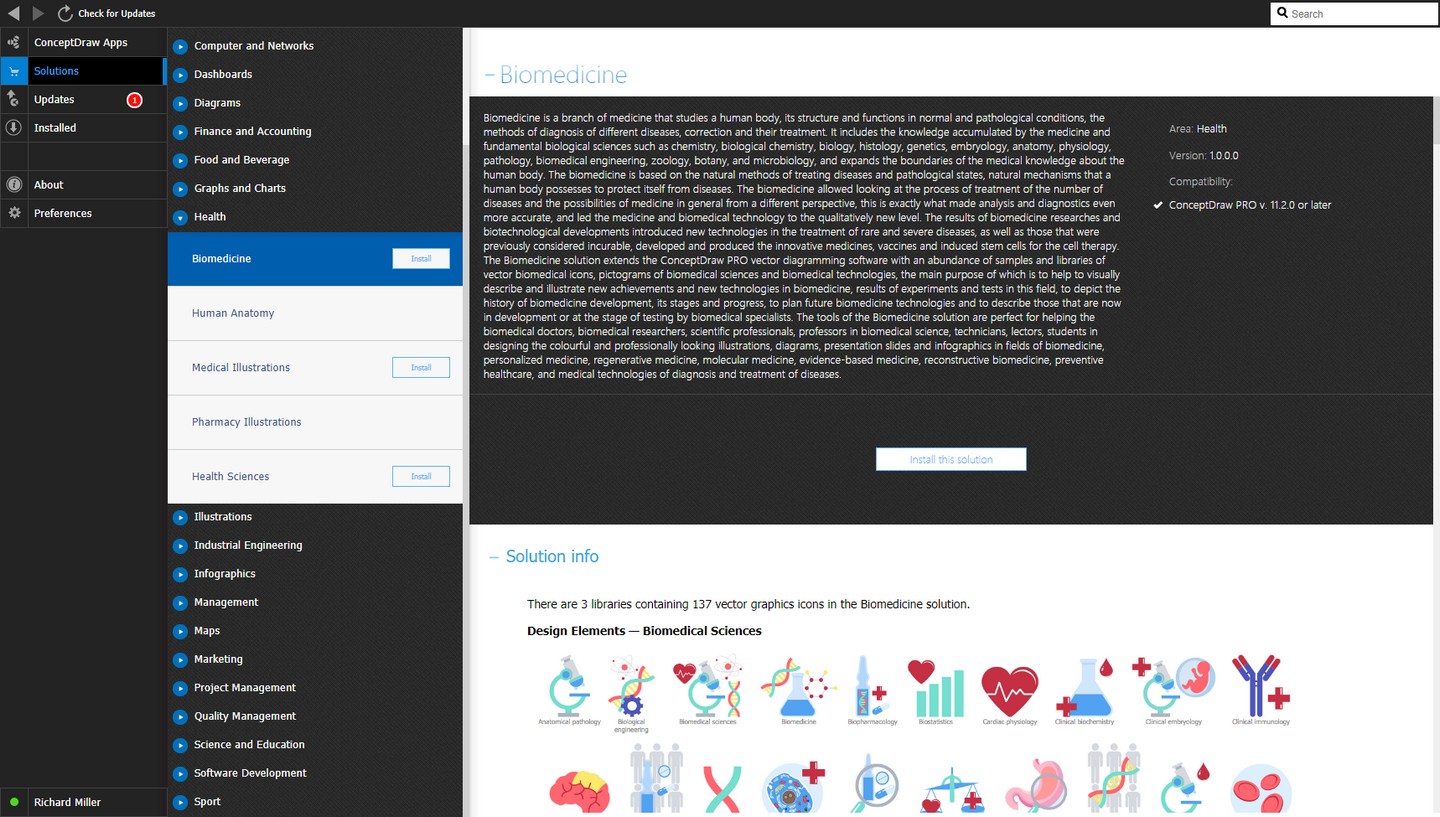
Start using
Start using the Biomedicine solution to make the professionally looking illustrations by adding the design elements taken from the stencil libraries and editing the pre-made examples that can be found there.
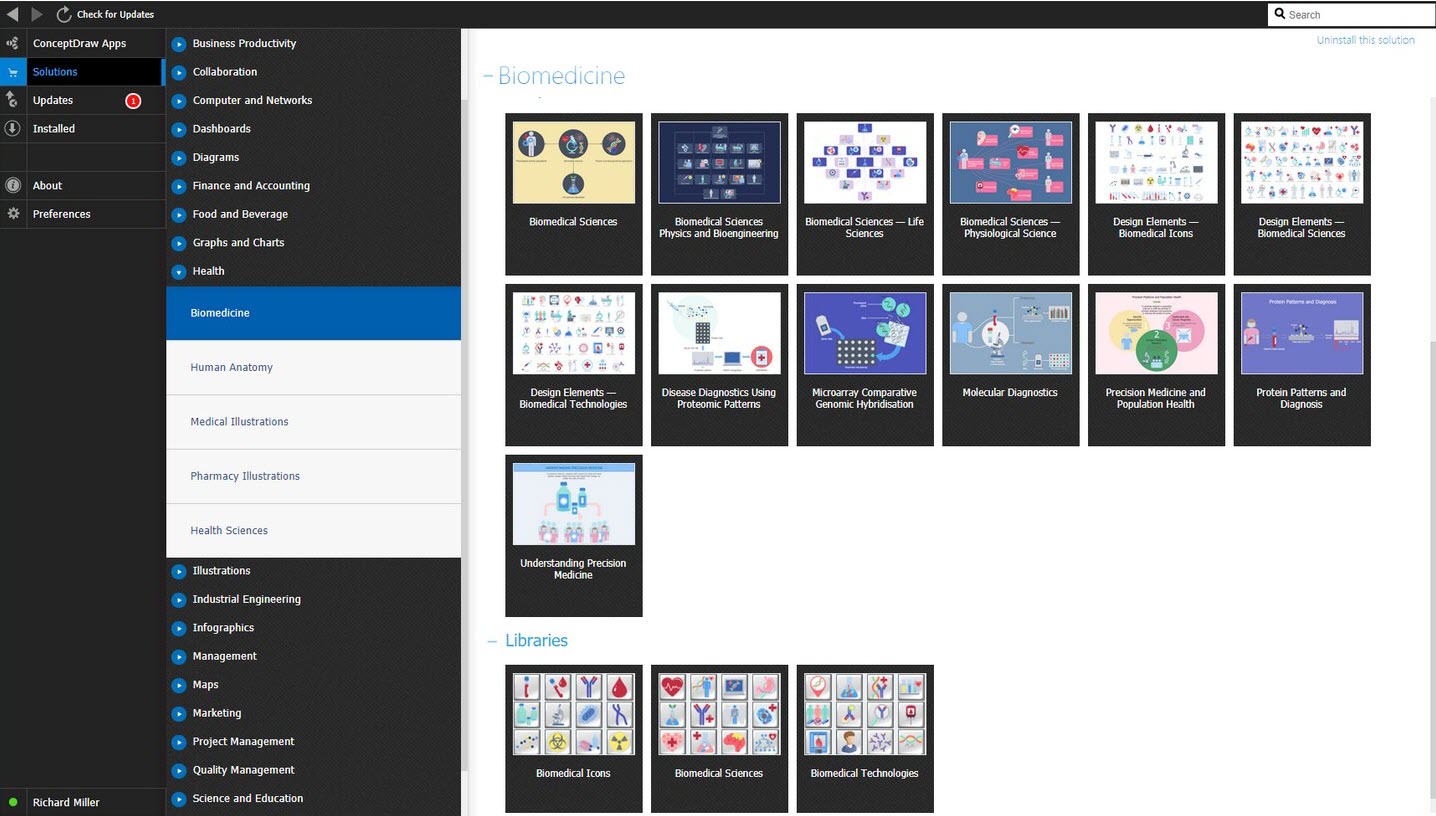
Biomedicine
The Biomedicine solution can be used for drawing biomedical and life sciences illustrations, infographics, diagrams, and presentation slides using the ConceptDraw DIAGRAM software.
Biomedicine is also considered as medical biology being known as a branch of medical science that applies both physiological and biological principles to clinical practice and general healthcare disciplines. This particular branch especially applies to physiology and biology. Biomedicine can also be related to a lot of other categories in biological and health-related fields. It has been the dominant health system for more than a century so far.
Biomedical disciplines and areas of specialty include:
- clinical biochemistry, molecular biology, systems biology, biotechnology, tissue engineering, cell biology, clinical embryology, medical diagnostics,
- biological engineering, nanobiotechnology, laboratory medical biology,
- cytogenetics, genomics, medical genetics, proteomics, gene therapy, metabolomics, molecular pathology, pharmacogenomics, molecular pathological epidemiology,
- bioinformatics, neuroscience, biostatistics, biomedical informatics (health informatics), systems biology, organ printing,
- medical microbiology, clinical immunology, clinical virology, parasitology,
- anatomical pathology, clinical physiology,
- analytical toxicology, etc.
The Biomedicine solution extends the ConceptDraw DIAGRAM charting and vector drawing software for designing biomedical illustrations, diagrams, presentation slides and infographics. Consisting of vector stencils libraries, graphic examples, and learning media, the Biomedicine solution can be found in the Health area of ConceptDraw Solution Park where it can be downloaded and so installed from.
The Biomedicine solution might be useful for many ConceptDraw DIAGRAM users, including:
- people who have no graphic designer skills:
- biomedical scientists who are involved in areas of biomedical research, medical research, medical test, experimental medicine, gene therapy, organ printing, therapeutic cloning, biomarker discovery, drug development, nanobiotechnology and drug discovery,
- life sciences researchers in areas of proteomics, genomics, bioinformatics, molecular biology, biostatistics, genetic engineering, biomedical engineering, tissue engineering, cell biology, genome editing, tissue engineering, cloning, system biology, and neuroscience,
- students and educators from adjacent and biomedical universities, medical university, and schools who learn about health informatics, health sciences, healthcare, metabolomics, etc.
- clinical professionals in areas of regenerative medicine, precision medicine, personalized medicine, molecular medicine, organ transplantation, stem-cell therapy, cell therapy, immunotherapy, molecular diagnostics, molecular medicine, immunoassay, medical laboratory tests, and pharmacogenomics,
- engineers and managers, involved in many areas of biomedical engineering, biological engineering (also known as “bioengineering”), red biotechnology and biomedical technology,
- writers, bloggers, and journalists involved in the life sciences area as well as biomedicine.
- graphic designers might also find using ConceptDraw DIAGRAM useful for creating both educational and scientific infographics for life sciences and biomedicine.
There are 3 vector stencils libraries included in the Biomedicine solution. First one, the “Biomedical icons” one includes the representations of Antibody, Bacteria, Biohazard symbol, Blood drop, Blood sample, Blood test, Cell culture flacks, Cell culture plates, Centrifuge tubes, Chromosome, Conical flask, Cryovial, Diagnosis, DNA, DNA stand, Electrophoresis gel, Gene chip, Microarray image, Microcentrifuge tubes, Micropippette, Micropippette tips, Microscope, Microscope slides, Microtiter plate, Patients, Petri dishes, Petri dish with bacterial colonies, Pipette controller, Protein mass spectrometry, Protein microarray, Protein pattern, Proteomic image, Proteomic pattern, Radiation symbol, Reagent bottles, Sample container, Sample swab and vial, Serological pipettes, Syringe, Test tubes, Test tubes in rack, Vacutainers, Tissue sample, Virus, White mouse, etc.

Vector stencils libraries
Apart from the mentioned, there are two more stencil libraries, such as “Biomedical sciences” and “Biomedical technologies”. They contain icon sets for fast and easy drawing life sciences and biomedical illustrations, infographics, diagrams and presentation slides while using the ConceptDraw DIAGRAM software.
There are many useful tools available from the Biomedicine solution for designing biomedical diagrams and infographics using the ConceptDraw DIAGRAM software. Apart from the already mentioned vector stencils libraries, they include the pre-made Biomedical infographic examples and learning media. Biomedicine solution allows designing the professionally-looking visuals for biomedicine and life sciences by all ConceptDraw DIAGRAM users, not only by professional graphic artists and designers. The final drawing may be used for biomedical presentations and publications, related websites or scientific documentation.